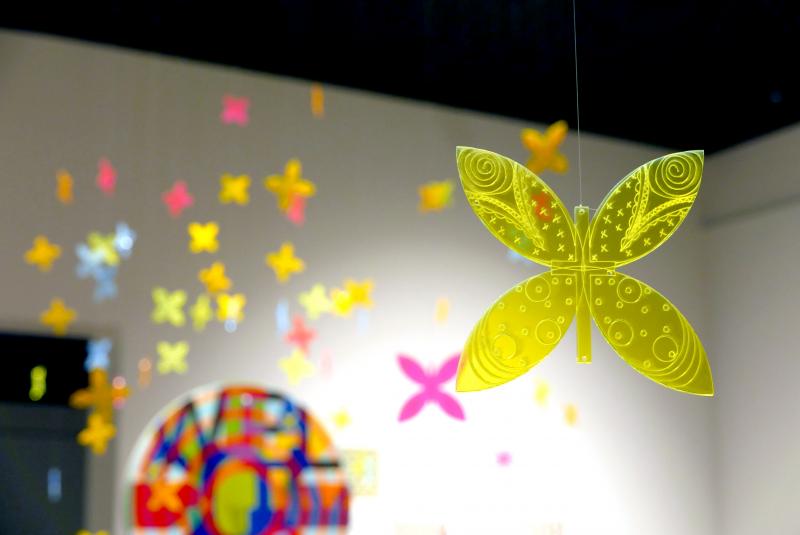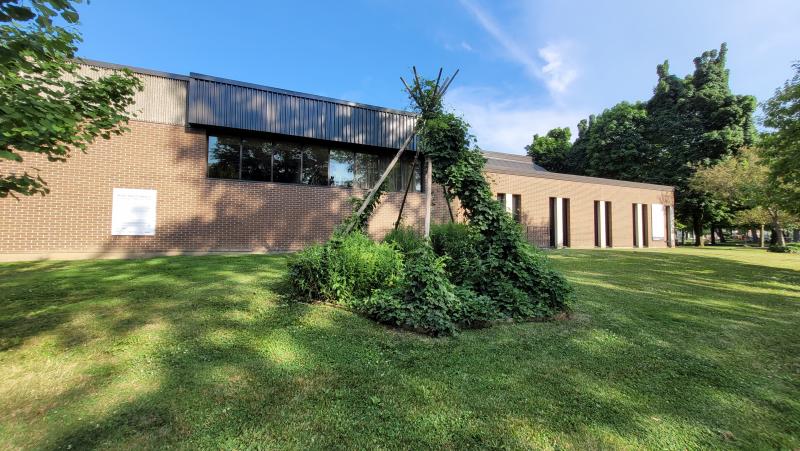In advance of the opening of Powerful Glow, KWAG Curator Darryn Doull sat down with Curator Lisa Myers for an informal discussion of themes and relations rooted in the exhibition.
Darryn Doull: Walking into Powerful Glow, one of the most apparent icons is the butterfly. How do you understand the figure of the butterfly as it inhabits this exhibition?
Lisa Myers: For Mike MacDonald, butterflies were teachers, and some have written about his work considering the butterfly as representing transformation. Within Powerful Glow, I see the butterfly as a symbol of learning, teaching, and transformation. It also reminds me of the interconnection of living beings and their less hierarchical interdependence where one is not deemed more important than the other. For example, the butterfly is just as important as the plant where it lays its eggs.
Cease Wyss and Anne Riley made an artwork called Soundtrack for the Radical Love of Butterflies (2018). My understanding of that project is that they were thinking about butterfly medicine as transformational and collected conversations with women-identifying and 2-spirit activists and artists who are creating change in communities through care work and activism. Those recordings are inspirational to me. Cease and Anne help me to think of butterflies as medicine and to think about what that medicine means.

DD: Mike MacDonald’s life and work is presented as a vital glow binding the artists in this exhibition together across media and generations. What keeps bringing you back to MacDonald’s work?
LM: In 2014, I included Mike’s single-channel work, Rat Art (1990), in an in-cinema presentation of experimental video art from the 1990s for ImagineNative Film and Media Festival. I was compelled by Mike’s work, having made gardens, and studied new media and video too., The more I read about his work, the more I wanted to learn and relate to his practice. I’ve learned from and I am inspired by his garden work. I’m starting to make a podcast about language and plant knowledge from the perspectives of learners. I’m working on this with Secwepemc artist and curator Tania Willard. So, I see his work as making important statements about land, resource extraction and medicines.
DD: You frame medicine as plants and food, but also as care and teaching, continuance and memory, and as a means to defend the land against ongoing colonial state violence. How can medicine heal both our bodies and our institutions, and be a tool for environmental remediation?
LM: The concept of medicine that I’m talking about is more than a physical dispensary of plants as a medicine to heal an ailment. I’m thinking of medicine as something intangible, that transforms, changes, shifts and may expand things – the ‘things’ it shifts can be understanding, perception, actions, practices, or interpersonal ways. I also want to think of medicine as encompassing all living things and not just those that are human centred.

This is something important that I see in Mike’s garden work: within them is medicine. Most of his gardens were created in urban spaces outside institutions, art galleries, and artist-run centres across the country, so creating a garden demands a certain kind of care from these organizations or institutions. It calls for people to break from their routines of care within collections and museums: to remediate, through change in practices and understanding, to consider relationship to the land and land back where they reside and what does care look like in those outdoor spaces. Another part of this is something that Wanda Nanibush wrote about in her essay, “The Earliest Adapters.” She reminds us that Mike’s work is not just about the environment as separate from the social, but that his work “expresses a worldview in which humans are not separate from the environment, or nature from culture.”|LS|1|RS|
With this view, we can think about medicine as something that teaches and something we can learn from.
DD: Continuance is also a central agent in the work that this exhibition can do upon us as viewers. What is the importance of continuance in Powerful Glow or in your own curatorial practice?
LM: There’s a concept that I learned from reading an article written by Potawatomi scholar Kyle Whyte. He writes about collective continuance and he relates it to the adaptive capacity of a society in relation to different systems such as food networks. I’ve been thinking of this in terms of language and plant knowledge. Mike’s gardens remind me what I know but also what I don’t know and what I want to learn, not only about the plants and pollinators but also about what it means to learn about plants and also learn language at the same time. How can I bring my little bit of language knowledge to my little bit of plant knowledge, and how does one encourage the other? So in this way, for me, language revitalization grows with the plants… well, ideally anyway. I’m interested in how that works, and how knowledge and language are carried between generations and territories. Continuance makes me think of intergenerational transfer of knowledge but in this case, transfer to and from land and ecologies.
Powerful Glow is on view at KWAG until 18 September 2022. Be sure to join us this Friday 17 June for the Opening Reception!
Images, in order of appearance:
1) Jordan Bennett, Welcome: Butterfly Garden (detail from installation), 2022. 3M reflective print on metal, steel, concrete, plexiglass. Courtesy of the Artist. Photo: KWAG.
2) Mike MacDonald, Planting one Another, 2019-present. Medicine and butterfly garden, Kitchener-Waterloo Art Gallery. Photo: KWAG.


